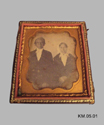Daguerreotype
| Nom de l'objet : | Daguerreotype |
| Type de l'objet : | Daguerreotype |
| Catégorie de l'objet : | Communications Artifacts |
| Sous-catégorie de l'objet : | Documentary Artifact |
| Matériaux : | Metal, coppe, brass fabric, velvet glass leather |
| Numéro d'accession : | KM.05.01 |
| Date de début de production : | 1860 |
| Date de fin de production : | 1870 |
| Description : | Daguerreotype and case; Portrait of Dr. and Mrs. Keir. The back and front of the case are separate due to the hinges being broken. Case is covered with brown leather and has an image of a thistle worked onto the front. The case closes with two tiny metal latches. The glass is kept from touching the actual surface of the daguerreotype by an ornate brass mat. The daguerreotype, brass mat, and glass are all held in place by a red velvet pinch-pad |
| Commentaires : | The daguerreotype process was invented in France in 1839 by Louis-Jacques-Mandé Daguerre. Early on photographic plates used in the process were not very sensitive. This meant that the exposure time to make a single image could be as long as 30 minutes. As a sitter could not stay perfectly still for that amount of time having a portrait taken was very nearly impossible. Early attempts at portraiture most often resulted in blurred faces and heads. Even when the process did improve exposure times were still substantially longer then what we are used to today. Those sitting for portraits often did not smile because holding a perfect smile for very long is hard to do. The result is that those pictured in early portraits often look quite grim. |
| Longueur : | 9.5 |
| Largeur : | 8 |
| Translittération de l'inscription : | None |
| Établissement : | Keir Memorial Museum |
| Ville de l'établissement : | Malpeque |
| Province de l'établissement : | Prince Edward Island |
Coordonnées de cette page web
-
Pour proposer des corrections ou des mises à jour sur cette page, veuillez contacter directement le Réseau canadien d’information sur le patrimoine (RCIP).
